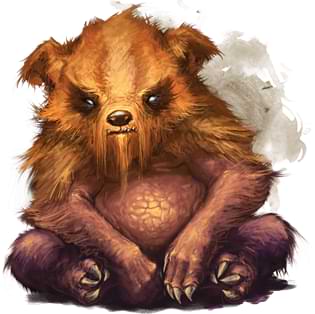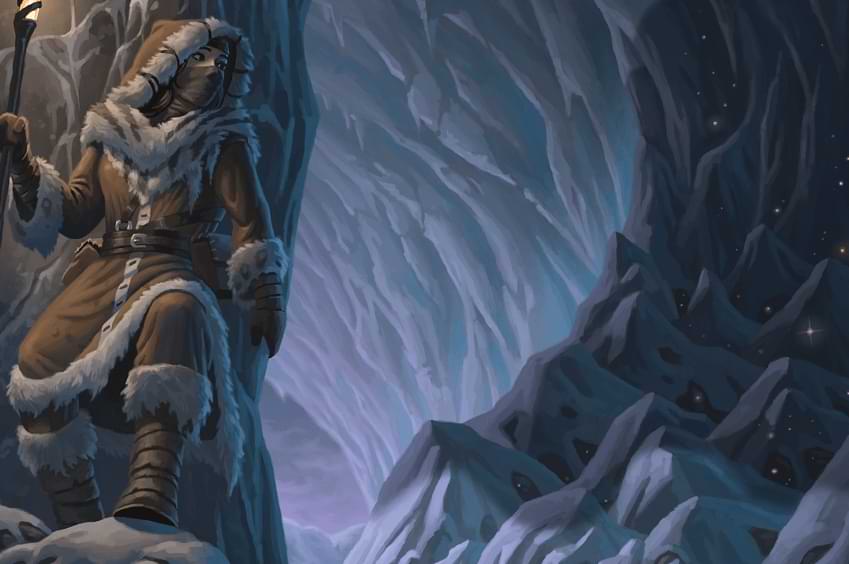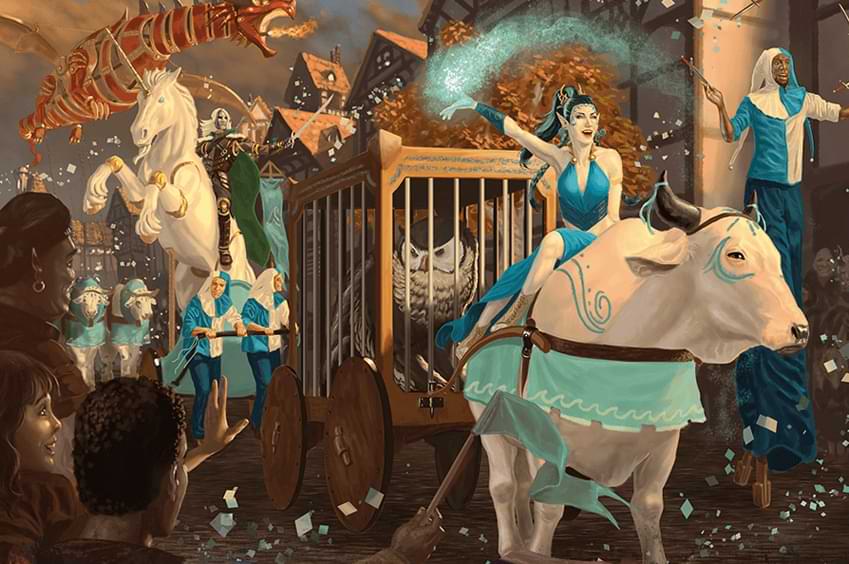I’ll start with a confession: I played D&D for many years before I considered hopping behind the screen, and when I finally did, I was terribly nervous. I worried, will I get the rules right? Will my story be satisfying? Will my players have a good time? And who am I to say whether you passed that Survival check, anyway? When I finally gave it a shot, though, I realized the most important question was the one I hadn’t thought to ask: Do you have any idea how rewarding it can be to take your friends on your very own epic adventure?
The answer is "very rewarding."
Once you’ve decided to build an adventure, you’ll discover your needs are very basic: you want to give your players a situation, present a problem, and see how (or whether) they manage to solve it. For some folks, constructing elaborate scenarios seems to come easily, but if you’re just starting it may seem like an intimidating prospect. The good news is that it’s a skill you can learn, like any other, and the bones of the process are simple. Ask yourself these questions, in any order, and write down your answers.
Step 1: What’s the problem?
 This is the basic gist of your adventure. The problem (or conflict) can be anything: a theft, a threat, an item mysteriously lost, a journey through dangerous waters, a secret that can’t get out... any of these could set your party on the road to adventure. Some conflicts are simple, and some complex; some are easy to deal with and some are difficult. Those qualities don’t always go together, either: a bandit attack over breakfast might be challenging but straightforward while unraveling a mystery with clues all over Waterdeep might be a little easier but a lot more complicated.
This is the basic gist of your adventure. The problem (or conflict) can be anything: a theft, a threat, an item mysteriously lost, a journey through dangerous waters, a secret that can’t get out... any of these could set your party on the road to adventure. Some conflicts are simple, and some complex; some are easy to deal with and some are difficult. Those qualities don’t always go together, either: a bandit attack over breakfast might be challenging but straightforward while unraveling a mystery with clues all over Waterdeep might be a little easier but a lot more complicated.
If you feel stuck for any idea at all, then start simple or, better yet, borrow! Elements from movies, books, or history can make great foundations for your story. Is there a particular terrain you’d like to explore? Look at the way adventures like Icewind Dale: Rime of the Frostmaiden draw on an environment for their stories. You could craft an adventure inspired by the time of year, pick out an interesting page in the Monster Manual and work backward from there, or base the whole session on a terrible pun. By the time you and your players get through with it, you’ll collectively have made something unique to your group and your memories.
By way of example, let's pick a beastie from the Monster Manual for our problem: A ferocious zorbo! And if we're setting this in one of the frigid Ten Towns of Icewind Dale, answers are already making themselves known to us: Something is attacking and eating livestock. What could it be?! How did a family of zorbo end up in the tundra? What is the correct plural of 'zorbo?'
See? You made one decision (a monster) and your story already has a ton of shape to it.
Step 2: Who needs you?
The most common answer to this question, and the easiest to start with, is that someone in your world needs your party’s help. This is your first NPC! They could be sympathetic, mean, trustworthy, or terrifying, but they are your best chance to explain the situation to your players and make them understand what’s at stake in your adventure. Play around with characters of different ages, reputations, and personalities. You’ll need to decide who they are, how they find the party (or vice versa), and, whether it’s gold, honor, or fear, you’ll need some idea of what will get your party on board. Remember, your characters exist in a wider world, and the problem they are going to deal with does, too. Who else might want to help your party, and who might want to stop them?
To continue our Z Quest- if a town's livestock is at risk, perhaps you're dealing with the Elder? They may not love outsiders, but they're desperate. They've sent scouts into the wilds to find assistance- and those scouts found your party's camp.
Step 3: What could go wrong?
Here’s where you start spinning your idea out into an adventure. What complications could arise on the path your players are taking? What are the natural dangers of this part of the world? If you’ve decided someone wants to stop your players, what will they try, and when? Perhaps the townspeople are unfriendly because they have a secret to protect. Perhaps someone else was supposed to take this journey and your players find there are some challenges to replacing them. Perhaps something in the woods wants to eat your Sorcerer for lunch!
Plenty can go wrong in our zorbo hunt, for example- your party could cross the wrong villager- or see something they weren't supposed to witness while staking out a snow-chicken coop. Perhaps left unchecked, the little jerks make the jump from livestock to live folks!
Step 4: What's the big finish? (Or, 'where is this all going?')
This is your adventure’s climax, and many times, this will be the first question you answer. A cave, surrounded by spiders. The island with the buried treasure… and its ferocious guard. The mansion of the corrupt baron, where you present him with the damning evidence you’ve found. It’s fine to come up with this first and work backward, but most adventures will have some kind of final confrontation to work towards. If you have a big secret or plot twist to reveal, and you didn’t use it as a complication in Step 3, here is where it’s going to land; what does that look like, and how does it change the situation for your characters?
Logic can help you through our example here. The zorbo would be desperate to stay warm. Perhaps it has found an underground hot spring. Maybe the blacksmith 'adopted' the little critters to keep them warm by the forge and got in over their head? You could have a big zorbo fight on your hands or a decision to make: to take pity on these poor suckers and try to take them somewhere they can thrive. After all, lookit their little faces. And who dropped them in Icewind Dale? Does that jerk need to be found?
Step 5: Why me? An adventurer’s plea
This is primarily a way to help flesh out your story. What are the personal stakes of this story for your players’ characters? Sometimes this question has an easy answer: if a wagon needs a guard and you’re affordable, you’ve got yourself a job! But this can also be an opportunity to draw deeper connections. Are there people, events, and themes in your PC’s backstories that would link up nicely with what you’re planning? Is there a source of conflict you can play on, or a choice you can offer them that will give them something meaningful to look back on?
Early on, this is a pretty simple answer. Adventuring is all about that gold! We have a zorbo problem, you have a solution, and we can pay you for it.
Step 6: Are your eyes bigger than your stomach? (aka 'watch the clock')
This is especially important for one-shots, but it’s always a good idea to pay attention to pacing, and keep in mind how much time you have, the size of your party, and how much you can really expect to get done in a session. It may be tempting to imagine a complex, sophisticated society, and to want your players to expose the decades-long treachery of the Viscount and his allies before the Queen’s reign is corrupted beyond repair. If you only have three hours, though, what’s the best, clearest version of that story? Perhaps there’s a specific assassination plot, scheduled for a specific noble’s wedding day, which can be prevented… if they act in time.
And look, we're very ready to delve into the exotic animal trafficker currently making their way through Icewind Dale who happens to be short a family of zorbos, and how their main client is a creepy necrophysicist that's using these creatures for all sorts of terrible experiments- and we're even more excited to explain what a necrophysicist is because it sounds very cool, but maybe that's all for another week.
Step 7: How’d we get into this?
You need a beginning for your adventure. It doesn’t have to be fancy; the classic answer to this question, “you all meet in a tavern,” is a classic for a reason; it’s a public space and, after all, most of your characters eat. You can begin with your party together or separate, let them wander towards town or ambush them in their bedrolls, but one way or another you’re going to need to introduce them to your answers for Steps 1 and 2. If this is also your players’ first time together, or their characters’ introductions to each other, try to give them something to react to and a little time to do it so they can get to know each other- but don’t forget Step 6: Watch the Clock.
Nothing wrong with starting in the middle- tell everyone that this morning they were strangers eating breakfast, and now some crazy scout is leading them into the blizzardy wilderness. Might as well introduce yourselves before the hike ends.
Step 8: How do we get out of it?
Another way to think of this is to ask, “What are some ways this could go?” Think about a few major possible outcomes for the conflict you invented in Step 1. Perhaps your heroes are able to resolve the problem completely, and the village is saved. Perhaps they are partially successful, and they evacuate the citizens, at least, who will live to rebuild another day. Perhaps they solve the problem but their solution creates a new, different problem; if you’re running a long campaign, this could be great news for you! You can never entirely predict what your players will do, but it’s a good idea to think through a couple of different options they might choose, and how that would work out for your world and your story.
Did they find the zorbos? Did they kill them? Did they spend a bunch of time befriending them so that the village would have the gift of domesticated zorbos? Keep your ending slushy- let the destination follow your players and their choices- don't push their choices to a destination.
Step 9: Wait, what if …?
Speaking of unpredictable players, remember to expect the unexpected! Keep some spare NPC and place names handy for when your party gets oddly attached to the stablehand or pumps the blacksmith for local history. Look at some of your plans for Step 3 and choose which pieces you might be able to expand on or drop, depending on how much time you have left in your session. Consider some backup plans for moving the plot along, in case a stray fireball has an unfortunate encounter with your crew’s only lead.
Let's see here, the Blacksmith's name is Grax the Hobgoblin, and let's not forget Dorall the dwarf, the Elder's daughter Wren who keeps trying to hang out with everyone, and when in doubt, there's always Tim. Who is Tim? Whoever you need him to be.
Step 10: What now? Putting it together
Once you have your answers for Steps 1-9, all that’s left to do is transform them into the elements you’ll need to play: a few key NPCs, settings, enemies, and skill challenges. You may want to try out the Encounters tool and see if the battle you’re planning seems about right for your group’s level. As you prep, focus your descriptions on what your characters might see, hear, or even smell. Add a memorable detail or two to your NPCs; a distinctive speech pattern, a cheery or grumpy temperament, or their extravagant fashion sense could help them stick in your players’ minds. For skill challenges, try brainstorming not just for success and failure but for multiple outcomes; what might they find on a spectacular success, or miss if they just barely make their way through the woods?
Running the adventure
Time to play! Remember, you are all here to have fun. No one expects you to be perfect. If you run into a game question, you can always pause to look up a rule, spell or feat in D&D Beyond, or you can also just make a quick call to keep things moving. Check out more great tips on running your first game here. Bear in mind that your party can help you world-build, too. You may want to let your players describe the look of their magic, suggest what they hope to find on an Investigation check, tell you what they remember about a town’s history, or even provide a name for that Innkeeper they keep coming back to for drinks.
As the adventure comes to an end, make sure to take a moment to celebrate everything that went well! When you narrate the end of the story or session, think about what has changed as a result of your player’s actions. It’s a great opportunity to reinforce something cool that each character did or discovered that day, and suggest what their stories might hold for the future. Of course, you can also take some time to think about what worked and what didn’t, and which parts you enjoyed most. Did you relish describing a spooky setting? Enjoy the looks on your players’ faces when your villains sprang from the shadows? Are you still laughing at something the Rogue said?
And then? Congratulations: you’re a DM. You and your party just told a story no one before you has ever told, and that’s yours to keep, forever. Feels good, right?
Start getting ready for the next adventure! Zorbos are optional.
Amy Dallen (@enthusiamy) is a performer, writer, and professional nerd who started rolling dice in elementary school and will probably never stop. You might know her work from Geek & Sundry, DC Universe, Collider, or her own twitch streams, where she plays games and runs a Book Club.










-
View User Profile
-
Send Message
Posted Mar 10, 2021Great article! Very helpful advice.
-
View User Profile
-
Send Message
Posted Mar 10, 2021As a new DM, this is great!
Also,
1st2nd.-
View User Profile
-
Send Message
Posted Mar 10, 2021Nice
-
View User Profile
-
Send Message
Posted Mar 10, 2021Pretty good stuff right here. As a homebrewing DM this was quite useful.
-
View User Profile
-
Send Message
Posted Mar 10, 2021yay! this is really cool and helpful!
-
View User Profile
-
Send Message
Posted Mar 10, 2021I think this will really help with some of my homebrew campaigns in the future.
-
View User Profile
-
Send Message
Posted Mar 10, 2021best article yet
-
View User Profile
-
Send Message
Posted Mar 10, 2021Great article! Very helpful for new DMs.
-
View User Profile
-
Send Message
Posted Mar 10, 2021This is super helpful! I'm planning on writing an adventure and this is a great place to start
-
View User Profile
-
Send Message
Posted Mar 10, 2021Nice! I would love to see an article on the 5-room dungeon method, that would be awesome for new DMs as well.
-
View User Profile
-
Send Message
Posted Mar 10, 2021You might find this series helpful, too.
-
View User Profile
-
Send Message
Posted Mar 10, 2021Neat! Will use and the ads are even minimal!
-
View User Profile
-
Send Message
Posted Mar 10, 2021Really useful tips! I myself am homebrewing a campaign for my first time DMing, and this helped a lot!
-
View User Profile
-
Send Message
Posted Mar 10, 2021My copy of Monster Manual does not have a "Zorbo" in it. A check of the DDB index puts this monster in Tomb of Annihilation. Some editor might want to correct this.
-
View User Profile
-
Send Message
Posted Mar 10, 2021Most of the article is based around Zorbos (Zorbi?), so I think it's a little too late to go back and change. I could be wrong, though.
EDIT: Oh, wait, did you want to change the "from the Monster Manual" part?
-
View User Profile
-
Send Message
Posted Mar 10, 2021This is an awesome article! Amy Dallen what adventures have you published ? My google fu is weak today
-
View User Profile
-
Send Message
Posted Mar 10, 2021Most of the article is based around Zorbos (Zorbi?), so I think it's a little too late to go back and change. I could be wrong, though.
I think he is referring to the fact it says Monster Manual and not the actual book it is printed in. Not that they used Zorbos.
-
View User Profile
-
Send Message
Posted Mar 10, 2021Yeah... I realized that after posting.
-
View User Profile
-
Send Message
Posted Mar 10, 2021I have a plan for a villain. He is an evil doppelgänger who turns the party against their npcs by impersonating their bard box and killing a villager in the form of the bard.
-
View User Profile
-
Send Message
Posted Mar 10, 2021> base the whole session on a terrible pun
I cracked up so bad XD